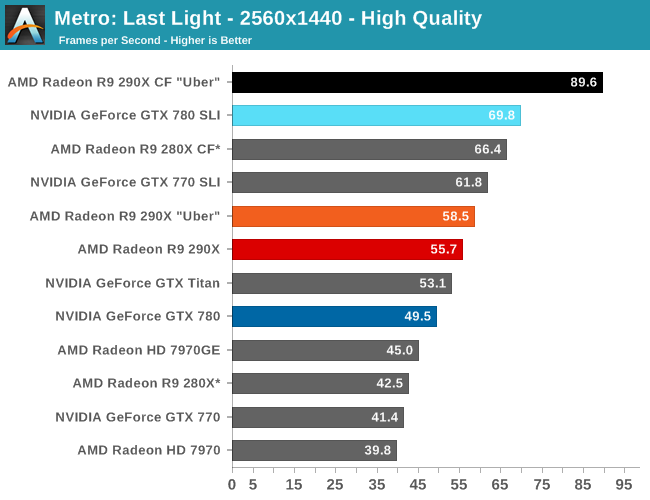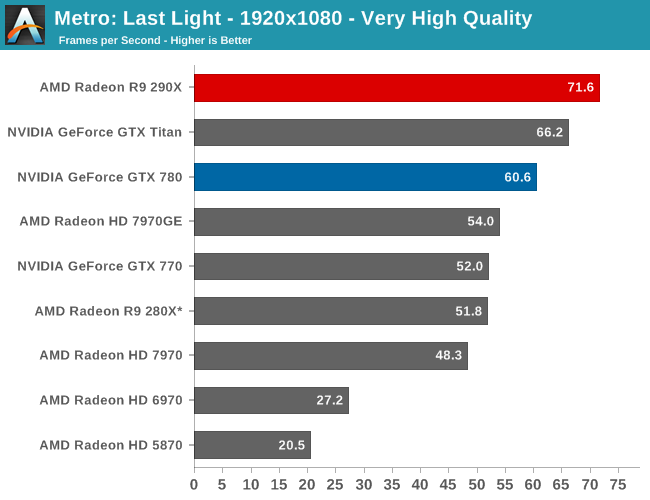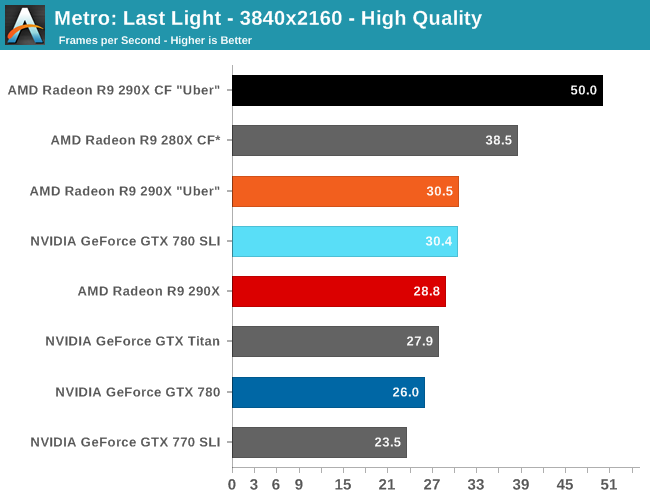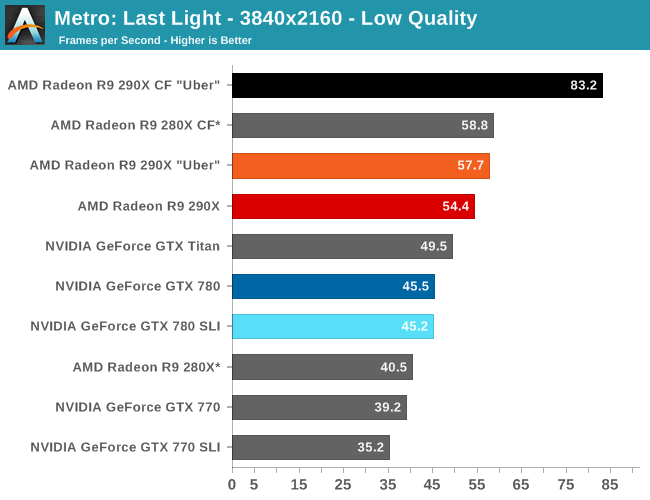The AMD Radeon R9 290X Review
by Ryan Smith on October 24, 2013 12:01 AM EST- Posted in
- GPUs
- AMD
- Radeon
- Hawaii
- Radeon 200
Metro: Last Light
As always, kicking off our look at performance is 4A Games’ latest entry in their Metro series of subterranean shooters, Metro: Last Light. The original Metro: 2033 was a graphically punishing game for its time and Metro: Last Light is in its own right too. On the other hand it scales well with resolution and quality settings, so it’s still playable on lower end hardware.


For the bulk of our analysis we’re going to be focusing on our 2560x1440 results, as monitors at this resolution will be what we expect the 290X to be primarily used with. A single 290X may have the horsepower to drive 4K in at least some situations, but given the current costs of 4K monitors that’s going to be a much different usage scenario.
With that said, for focusing on 4K on most games we’ve thrown in results both at a high quality setting, and a lower quality setting that makes it practical to run at 4K off of a single card. Given current monitor prices it won’t make a ton of sense to try to go with reduced quality settings just to save $550 – and consequently we may not keep the lower quality benchmarks around for future articles – but for the purposes of looking at a new GPU it’s useful to be able to look at single-GPU performance at framerates that are actually playable.
With that said, starting off with Metro at 2560 the 290X hits the ground running on our first benchmark. At 55fps it’s just a bit shy of hitting that 60fps average we love to cling to, but among all of our single-GPU cards it is the fastest, beating even the traditional powerhouse that is GTX Titan. Consequently the performance difference between 290X and GTX 780 (290X’s real competition) is even greater, with the 290X outpacing the GTX 780 by 13%, all the while being $100 cheaper. As we’ll see these results are a bit better than the overall average, but all told we’re not too far off. For as fast as GTX 780 is, 290X is going to be appreciably (if not significantly) faster.
290X also does well for itself compared to the Tahiti based 280X. At 2560 the 290X’s performance advantage stands at 31%, which as we alluded to earlier is greater than the increase in die size, offering solid proof that AMD has improved their performance per mm2 of silicon despite the fact that they’re still on the same 28nm manufacturing process. That 31% does come at a price increase of 83% however, which although normal for this price segment serves as a reminder that the performance increases offered by the fastest video cards with the biggest GPUs do not come cheaply.
Meanwhile for one final AMD comparison, let’s quickly look at the 290X in uber mode. As the 290X is unable to sustain the power/heat workload of a 1000MHz Hawaii GPU for an extended period of time, at its stock (quiet settings) it has to pull back on performance in order to meet reasonable operational parameters. Uber mode on the other hand represents what 290X and the Hawaii can do when fully unleashed; the noise costs won’t be pretty (as we’ll see), but in the process it builds on 290X’s existing leads and increases them by another 5%. And that’s really going to be one of the central narratives for 290X once semi-custom and fully-custom cards come online: Despite being a fully enabled part, 290X does not give us everything Hawaii is truly capable of.


Moving on, let’s talk about multi-GPU setups and 4K. Metro is a solid reminder that not every game scales similarly across different GPUs, and for that matter that not every game is going to significantly benefit from multi-GPU setups. Metro for its part isn’t particularly hospitable to multi-GPU cards, with the best setup scaling by only 53% at 2560. This is better than some games that won’t scale at all, but it won’t be as good as those games that see a near-100% performance improvement. Which consequently is also why we dropped Metro as a power benchmark, as this level of scaling is a poor showcase for the power/temp/noise characteristics of a pair of video cards under full load.
The real story here of course is that it’s another strong showing for AMD at both 2560 and 4K. At 2560 the 290X CF sees better performance scaling than the GTX 780 SLI – 53% versus 41% – further extending the 290X’s lead. Bumping the resolution up to 4K makes things even more lopsided in AMD’s favor, as at this point the NVIDIA cards essentially fail to scale (picking up just 17%) while the 290X sees an even greater scaling factor of 63%. As such for those few who can afford to seriously chase 4K gaming, the 290X is the only viable option in this scenario. And at 50fps average for 4K at high quality, 4K gaming at reasonable (though not maximum) quality settings is in fact attainable when it comes to Metro.
Meanwhile for single-GPU configurations at 4K, 4K is viable, but only at Metro’s lowest quality levels. This will be the first of many games where such a thing is possible, and the first of many games where going up to 4K in this manner further improves on AMD’s lead at 4K. Again, we’re not of the opinion that 4K at these low quality settings is a good way to play games, but it does provide some insight and validationg into AMD’s claims that their hardware is better suited for 4K gaming.










396 Comments
View All Comments
AtwaterFS - Thursday, October 24, 2013 - link
Nice, Nvidia has two choices, drop prices substantially, or drop trou.I certainly hope its the former, as I have no interest in seeing Jen-Hsun's pig in a blanket...
Wreckage - Thursday, October 24, 2013 - link
Not really the Titan slayer we were hoping for.After all this wait and hype it's not surpassing last years GK110. I guess we don't look for big gains in new chips anymore.
The Von Matrices - Thursday, October 24, 2013 - link
This is on the same process node as Titan. Big advances don't happen without process node shrinks, regardless of manufacturer.ninjaquick - Thursday, October 24, 2013 - link
A million times this... GCN is superior to Kepler, and probably Maxwell as well. It doesn't waste tons of die-space on large cache/special decoders/legacy bullshit. Game creators want massive arrays of simple math units that can voraciously crunch numbers, and that is what GCN delivers.EJS1980 - Thursday, October 24, 2013 - link
"GCN is superior to Kepler, and probably Maxwell as well"...HEHEH..... THIS IS PRETTY FUNNY, MAN......THANKS.....I NEEDED THAT! :PWill Robinson - Thursday, October 24, 2013 - link
Yeah right Wreckage...only slayed Titan by about $500 LOLIdiot.
chizow - Thursday, October 24, 2013 - link
Great price and performance from AMD without a doubt, it's not quite a clean sweep but it is certainly a convincing victory for R9 290X, especially at higher resolutions. 780Ti may come close or even exceed 290X, but the damage to Nvidia's product stack has been done.The symmetrical irony here is that this generation's price escalation that began at $550 with AMD's first 28nm part, Tahiti, has come full circle and brought back to balance with AMD's last 28nm part, Hawaii, again at that $550 price point.
I'm happy to see some balance back in the GPU market though, I stated this month's ago at 690 and Titan launch, that this $1K pricing model was an unsustainable business strategy for Nvidia. Now it's going to bite them squarely in the ass. They'll now reap what they sow and have to deal with the angst and anger from all of their most loyal fans who will undoubtedly feel as if they were cheated by the 690, Titan and even 780.
chizow - Thursday, October 24, 2013 - link
I guess it couldn't be all good news though, it looks like the leaked thermals, power consumption and acoustics weren't exaggerated. Definitely loud and hot, with high operating temps. I guess AMD really pushed the GPU to the max, I doubt there will be much more OC headroom, at least with the reference cooler.If Nvidia wasn't so greedy with 690/Titan/780 pricing 290X might've been the next Fermi with mixed reactions, but I'm sure the price and performance will overshadow heat/power concerns.
t41nt3d - Thursday, October 24, 2013 - link
NVIDIA won't be bitten in the ass at all due to the prices of the 690s and Titan. A god awful amount of people have paid $1000 (Including me) for one or more of these cards, and it's taken /8 Months/ for AMD to release a card that goes back and forth with the Titan - Doesn't outright beat it in some games, can go either way.NVIDIA have made a crapload of money from their two overpriced cards and have been reaping off this for a long time now, all they need to do is lower prices and no money lost. It's AMD who's been letting them get away with those prices for so long.
It seems a perfectly viable business strategy for them to have done what they've done and to be so successful at it.
chizow - Thursday, October 24, 2013 - link
I guess we will see, their job just got that much harder to try to sustain this $1000 pricing model now that a $550 card now matches and sometimes outperforms their $1000 card. What kind of performance do you think they're going to need next time to try and justify a $1000 pricetag?Again, Nvidia went down the path of an unsustainable business model predicated on the fact they would be an entire ASIC ahead of AMD. That lead was clearly short-lived due to Kepler's excellent overall performance, but Hawaii brought that dream back down to reality. Sure a bit late, but still in time to crash Nvidia's $1K parade.